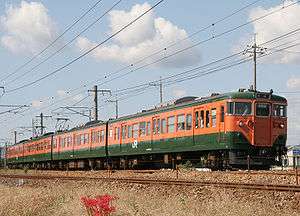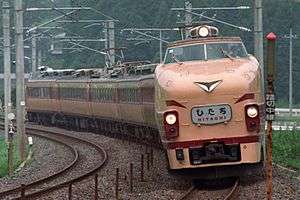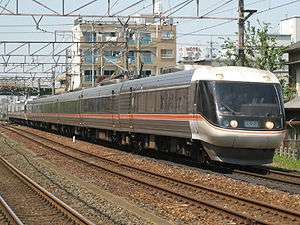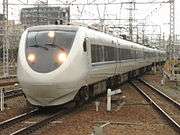113 series
| 113 series | |
|---|---|
|
JR-West 4-car set on a Sanyō Main Line service, October 2009 | |
| In service | 1963–Present |
| Manufacturer | JNR Niitsu Works, Hitachi, Kawasaki Heavy Industries, Kinki Sharyo, Kisha Seizo, Nippon Sharyo, Teikoku Sharyo, Tokyu Car Corporation |
| Constructed | 1963–1990 |
| Refurbishment | 1998– (for selected trains) |
| Number built | 2,900 vehicles |
| Number in service |
156 vehicles (JR-West) 12 vehicles (JR Shikoku) |
| Operator(s) |
|
| Depot(s) |
Kyōto Miyahara Fukuchiyama Hiroshima Takamatsu |
| Line(s) served | Various |
| Specifications | |
| Car body construction |
Steel Stainless steel (SaRo 124/SaRo 125) |
| Car length | 20,000 mm (65 ft 7 in) |
| Width | 2,900 mm (9 ft 6 in) |
| Doors | 3 pairs per side |
| Maximum speed | 110 km/h (70 mph) |
| Traction system | Resistor control |
| Deceleration | 3.0 km/h/s |
| Electric system(s) | 1,500 V DC |
| Current collection method | overhead catenary |
| Braking system(s) | Dynamic brake, Electric brakes, air brakes |
| Safety system(s) | ATS-SN, ATS-P |
| Track gauge | 1,067 mm (3 ft 6 in) |
The 113 series (113系 Hyaku-jūsan-kei) is a Japanese suburban electric multiple unit (EMU) train type introduced in 1963 by Japanese National Railways (JNR), currently operated by West Japan Railway Company (JR-West) and Shikoku Railway Company (JR Shikoku), and formerly also operated by East Japan Railway Company (JR East) and Central Japan Railway Company (JR Central).
The design was derived from the earlier 111 series, and used newer MT54 motors with an output of 120 kW. They are used in the mild temperature areas of Japan, due to their brakes not being capable of handling cold weather. The 115 series were built to operate in colder areas.
Variants
113-0 series
These sets were the first of the 113 series, and were put to use on the Sobu and Yokosuka Lines. They had the same body structure as the 111 series, only the driver's cab had been extended. In 1970, AU73X, AU74X, AU75X type air conditioning was fitted experimentally to sets operated in the Kansai area. The test was successful, and hence was fitted into the majority of the cars. Production of the -0 series ceased in 1973, and most sets have now been withdrawn.
113-0 series (JR Shikoku)
Three 113-0 sets were transferred to JR Shikoku from JR East for refurbishment. Following refurbishment, they differed externally from most 113 series trainsets because they have lower front destination signs and rectangular headlights. Each set also came in a different color scheme; set 1 in a coat of lime green surrounding the windows with light blue; set 2 in red and pink; and set 3 in orange and yellow. All have a ribbon of silver on the top and bottom, and the colors were arranged in the same pattern.
| Former Numbering | Set 1 | Set 2 | Set 3 | Current | Set 1 | Set 2 | Set 3 |
|---|---|---|---|---|---|---|---|
| Car 1 | KuHa 111-223 | KuHa 111-198 | KuHa 111-222 | → | KuHa 113-1 | KuHa 113-2 | KuHa 113-3 |
| Car 2 | MoHa 113-257 | MoHa 113-270 | MoHa 113-272 | → | MoHa 113-1 | MoHa 113-2 | MoHa 113-3 |
| Car 3 | MoHa 112-257 | MoHa 112-270 | MoHa 112-272 | → | MoHa 112-1 | MoHa 112-2 | MoHa 112-3 |
| Car 4 | KuHa 111-532 | KuHa 111-529 | KuHa 111-528 | → | KuHa 112-1 | KuHa 112-2 | KuHa 112-3 |
113-700 series
These sets were built for use on the Kosei Line, due to the heavy amounts of snowfall in the region. They feature semi automatic doors, snowploughs and improved brakes. Some trains were also transferred to the Sagano Line.
113-1000 series
These sets were introduced from 1972, and were an improved version of the 113-0 series, for use on the Sobu and Yokosuka Lines. They incorporated fire resistant materials, sealed beam headlights and air conditioning. These trains were used around the Boso area, on the Narita Line, Kashima Line, Sotobo Line, and Uchibo Line. However, due to minor modifications of the ATC and air conditioning in some trains in April 1972, some of the trains from the Boso area were transferred for use on the Tokaido Line.
113-1500 series
These sets were an improvement on the 113-1000 series and these sets were all located at Ofuna. They ran on the Sobu and Yokosuka Lines and on the Tokaido Line. All 113-1500 series trains were fitted with ATC-5 and ATS-P/SN.
113-3800 series
These are JR-West 2-car sets which were converted in 2001 by building new cabs at one end of former MoHa (non-driving motor) cars.
Livery variations
-
"Shonan" livery
-

"Suka" livery
-

Hanwa "Blue Liner" livery
-

Kasuga livery
-

(Old) Fukuchiyama Line livery (113-800 series)
-

Fukuchiyama "wanman" livery (113-3800 series)
-

Sagano "wanman" livery (113-5300 series)
-

(Old) Wakayama livery (113-2000 series)
-

Shirahama Panda livery
-

Setouchi livery
-
Kansai refurbished livery
-
Hiroshima refurbished livery
-

Obama Line livery
-

Setouchi area livery
-

Kyoto and Kitakinki area livery
-

Shikoku livery trainset 1
-
Shikoku livery trainset 2
-

Shikoku livery trainset 3
Preserved examples
- KuHa 111-1072 (front end only, preserved privately at a hotel in Ueda, Nagano)[1]
- KuHa 111-2152 (front end only, preserved privately at a hotel in Ueda, Nagano)[1]
References
Further reading
- Fukuhara, Shunichi (13 July 2013). 111・113系物語 [The 111 and 113 series story]. Japan: JTB Can Books. ISBN 978-4533092848.
External links
| Wikimedia Commons has media related to 113 series. |
"JR East 113 series EMU information". Archived from the original on 2011-05-22. Retrieved 2011-12-10. (Japanese)




